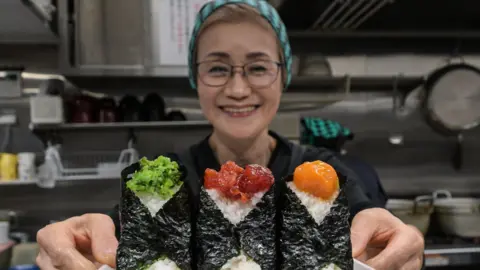### The Tumultuous Tale of Rice and Politics in Japan
Japan recently faced a significant political upheaval, triggered by a seemingly innocuous joke made by Taku Eto, the country’s farm minister. At a local fundraiser, Eto remarked that he had never needed to buy rice, as his supporters generously gifted him plenty of it. Little did he know that this flippant comment would not only draw nationwide outrage but also lead to his resignation.
The backdrop of Eto’s controversial remarks is particularly poignant given the current economic climate, characterized by Japan’s first cost-of-living crisis in decades. The price of rice—a beloved staple in Japanese cuisine—has more than doubled over the past year, leaving many consumers in dire straits. Imported varieties have become scarce, further exacerbating the situation.
Following a wave of backlash, Eto issued an apology, admitting that he had indeed “gone too far” and chose to resign when opposition parties threatened a no-confidence motion against him. This incident dealt yet another blow to Prime Minister Shigeru Ishiba’s minority government, which was already grappling with dwindling public support.
One cannot overlook the symbolic significance of rice in Japanese culture. It has historically served as a trigger for political unrest; a notable incident in 1918 saw riots over soaring rice prices leading to a government being toppled. Hence, it is not surprising that rice prices—and the resulting public anger—are influencing Ishiba’s plummeting approval ratings.
### Economic Pressures and Miscalculations
The economic dynamics behind the rice crisis can be attributed to a miscalculation by the Japanese government, as explained by agricultural economist Kunio Nishikawa from Ibaraki University. Until 1995, the government strictly controlled rice production through agricultural cooperatives. Although this regulatory framework has been abolished, the agriculture ministry continues to publish demand estimates. However, according to Nishikawa, the estimates for 2023 and 2024 were flawed, churning out a predicted demand of 6.8 million tonnes when the actual need was around 7.05 million tonnes.
This increase in demand has been fueled not only by an uptick in tourism but also by a post-pandemic trend of dining out. Yet, actual production fell tantalizingly short, at just 6.61 million tonnes, much lower than anticipated. Alongside demand, factors such as extreme weather conditions have impaired the quality and quantity of rice produced.
### The Farmers and Their Woes
For many rice farmers like Kosuke Kasahara of Niigata, the economic pressures of running a rice farm have been untenable for years. Farmers are often unable to profit, with production costs soaring well above selling prices. The stark reality is that various governmental incentives have nudged farmers toward producing non-rice crops, as they have found rice farming less lucrative.
Moreover, some younger farmers have opted to cultivate rice suited for sake or rice crackers, indicative of a shifting agricultural landscape. The recent spike in prices, where a 60 kg bag of rice retails for between 40,000 and 50,000 yen, has prompted a mixed reaction. Although it spells good news for struggling farmers, it leaves many consumers apprehensive about their shopping bills.
The government has resorted to auctioning emergency rice reserves in a bid to stabilize prices, creating further consternation among farmers, who felt betrayed by previous assurances that these reserves would only be tapped in dire situations.
### Broader Implications and Future Trends
The rice situation in Japan reflects a larger trend dominating global markets, particularly in Southeast Asia where approximately 30% of global rice production occurs. Pressure from economic, political, and environmental factors has driven shortages in recent years. In an unprecedented move, Japan has begun importing rice from South Korea—something that hasn’t happened in a quarter of a century—as they wrestle with domestic shortages. There are also discussions around potentially importing U.S. rice as negotiations surrounding trade agreements continue.
Consumer sentiment remains strong against foreign rice. Many, like first-time mother Memori Higuchi, express sustainable preferences, favoring local production over imports. As Higuchi highlighted, there needs to be a method to ensure farmers can thrive while providing quality domestic products for consumers.
### Conclusion
As Japan gears up for key national elections this summer, balancing the interests of both consumers and farmers—especially older demographics known for their voting tendencies—has become a paramount consideration for politicians. For Prime Minister Ishiba’s government, navigating these complexities while restoring public confidence in rice prices will be crucial for its standing in the coming elections. In this political landscape shaped by the economic realities of rice production, the fate of the cabinet minister serves as a stark reminder of the intricate ties between food prices and political stability in Japan.



